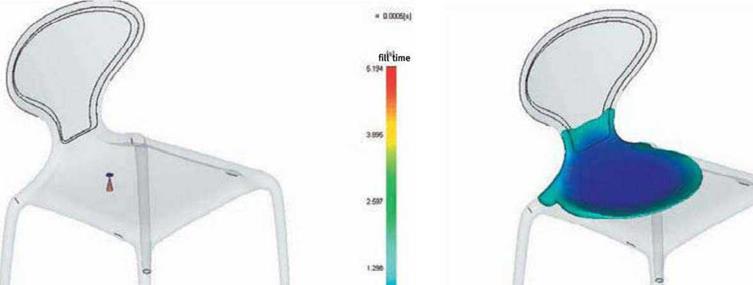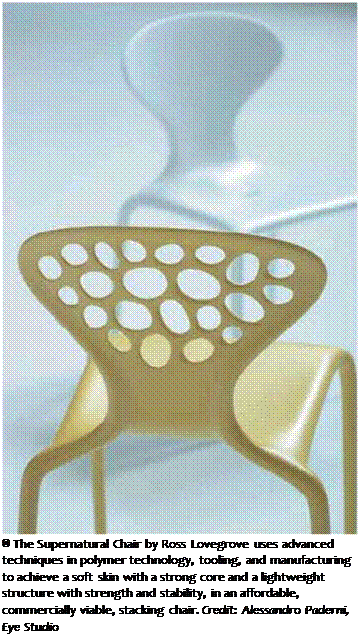 The Supernatural is his answer to a perceived need for “sense” in a plastic, stacking chair. “Right at the beginning I’ve personally always wanted to do a really good plastic chair,” Lovegrove says. “I don’t do many chairs. But I like the idea of doing things that reflect the culture of the day. If you look at everything I do, they’re very technologically innovative. There are a few chairs on the market that did pioneer polymer technology. But I always felt that there was a missing link, a chance to produce a chair that has the visual stability of a four-legged stacking chair, but with something organic, a more liquid form that reflects the material.”
The Supernatural is his answer to a perceived need for “sense” in a plastic, stacking chair. “Right at the beginning I’ve personally always wanted to do a really good plastic chair,” Lovegrove says. “I don’t do many chairs. But I like the idea of doing things that reflect the culture of the day. If you look at everything I do, they’re very technologically innovative. There are a few chairs on the market that did pioneer polymer technology. But I always felt that there was a missing link, a chance to produce a chair that has the visual stability of a four-legged stacking chair, but with something organic, a more liquid form that reflects the material.”
Lovegrove has been working with polymers for over twenty-five years. He also has a long-standing relationship —and friendship — with Moroso. When Patricia Moroso told him they were ready to do their first polymer chair and they wanted him to design it, he was thrilled. “They’re a relatively small company, so for them to invest in a full-blown, gas-injected, polyamide injection-molded chair is a big undertaking.” Lovegrove continues, “It was a massive responsibility on my behalf to do something fresh, new, culturally iconographic, but at the same time, something that would have really great commercial potential. Something that respected both the process and the material. It was a wonderful opportunity that allowed me to exercise the maximum of my professionalism.”
The technology provided Lovegrove with new possibilities for both design and commercialization. “With the advent of injecting gas into certain sections of products, you can remove material to make them lighter, and also, in a way like bones, you make them stronger,” he points out. To find an open, airy, asymmetric pattern that pleased him and would maximize the potential in the manufacturing process, he generated at least ten, digitally-produced patterns. “Imagine if you stretched a piece of balloon and then you got someone to stick a pin in it, or heat it at points, so it will stretch and a hole will appear that will gradually open,” Lovegrove explains. “That’s a form of tension that I’ve tried to put into the aesthetic of the chair. If you look at a leaf that’s been eaten away, it’s kind of like that. It’s a manmade product, but it has a sense of true nature.”
This idea of allowing organic forms into the design vernacular of a plastic object is carried throughout all parts of the product. “What one is trying to do,” notes Lovegrove, “is to incorporate the bioengineering of it so it feels natural, so it feels as one. If you look at the back of the chair, the strength is generated out of the back leg that blends into the neck, and then it diminishes. It
 |
|||
|
|||
|
|||
|
|||
|
|||
|
|||
|
|
||
|

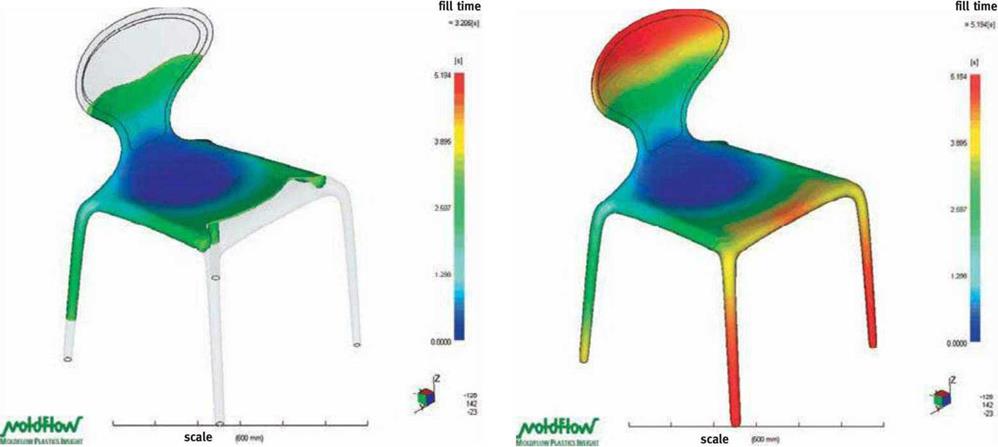

starts as a leg with a very particular dimensions, then that section changes orientation, and then diminishes around the back of the seat, of the chair.” This design is not only visually alluring but is also expected to add comfort to the chair, allowing the legs to remain stiff and stable, but giving the back some flex.
The technology also offered other options that enhanced the sensual aspects of the chair by giving it internal strength and a more smooth surface quality and ability to hold color. “What’s beautiful about the chair, is that it has two different densities in the same chair,” Lovegrove explains. “There’s a higher concentration of glass in the central core and less glass in the skin. To get added strength you need more glass, but it’s transparent and doesn’t allow you to produce darker colors because you’ll see the stratification. And the glass will migrate to corners, which causes some variation in the color. So we’ve created a skin with a lot less glass in it, like 40 percent in the core and 10 percent in the skin. We can control one material density internally and one externally.”
For all his fascination with the opportunities technology offers him to realize his design visions, for Lovegrove, it’s all a tool that he keeps an arm’s length away from the creative act. He designs by sketching. “I always buy these particular sketchbooks, which have become a bit legendary, now. They are made in Venice. When they run out, I go to Venice and get more. Any excuse to go to Venice!” he laughs. And then adds, “The thought of drawing something that has meaning on anything else, it just hurts me.” To get his sketches into digital form, he relies on technical design staff in his office, with whom he works closely, but also from a comfortable distance. “I don’t touch the computer and I probably never will,” he says. “Because it’s not intuitive and I’m always on the go and I don’t want to depend on a power source to create. Also, pressing a square key to make a shape doesn’t link for me. The drawing, which is a deeply personal act, is becoming ever more valuable,” he notes.
The Supernatural Chair comes in two versions, one with perforations, and another with a solid back. Both are made from the same tool, by just switching out a single separate steel insert. To Lovegrove’s understanding, this is the first time two chairs have come from the same mold. “I don’t think anyone thought of it before. It might be as simple as that,” he says. However, this added versatility is part of his sense of responsibility as a designer. “I’m very much interested in extrapolating the most from the least in whatever I do,” he points out. “That’s why my work looks trim, fit, and skeletal. With this particular chair, I’m trying to get a certain biodiversity in the product. If someone’s putting up so much money—and from such a small company—I’m going to try and extrapolate the most from the least for them.”

 Lovegrove loves the integrity and possibilities of open-back version. “The intention of the perforations is to add a polysensorial effect from the chairs when light passes through to create shadows that enrich space and provide unexpected layers of beauty to architectural surfaces,” he says. “This effect is increased by the layering of the chairs and their orientation, their variety of colors, and also when stacked because the experience becomes very three-dimensional, like sunlight through leaves on a tree.” He also points out that this model was the most conservative of his proposals for a pattern, but necessary for production concerns. “It’s important to push, but important to not go into territories that are going to cost people a lot of time and money or cause problems. I try to push it as far as I can, and then, by the time you pull back, you have something that has a greater acceptance. What I’m trying to do,” he concludes, “is to give the product its maximum chance in life. That’s my duty.”
Lovegrove loves the integrity and possibilities of open-back version. “The intention of the perforations is to add a polysensorial effect from the chairs when light passes through to create shadows that enrich space and provide unexpected layers of beauty to architectural surfaces,” he says. “This effect is increased by the layering of the chairs and their orientation, their variety of colors, and also when stacked because the experience becomes very three-dimensional, like sunlight through leaves on a tree.” He also points out that this model was the most conservative of his proposals for a pattern, but necessary for production concerns. “It’s important to push, but important to not go into territories that are going to cost people a lot of time and money or cause problems. I try to push it as far as I can, and then, by the time you pull back, you have something that has a greater acceptance. What I’m trying to do,” he concludes, “is to give the product its maximum chance in life. That’s my duty.”

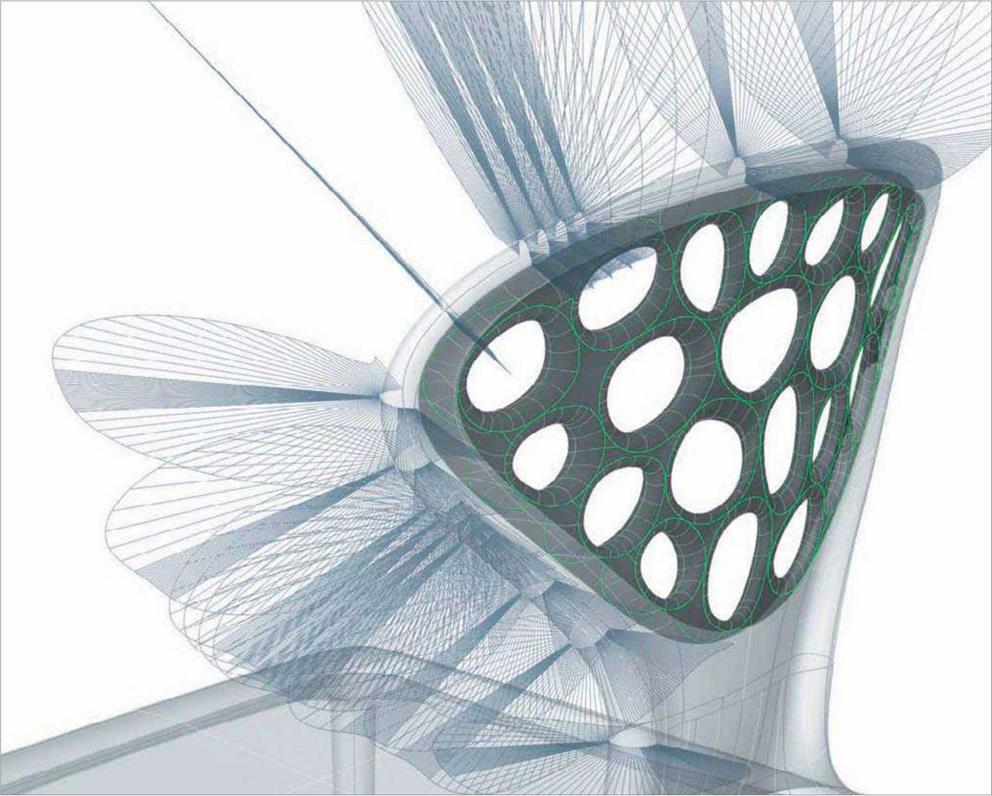

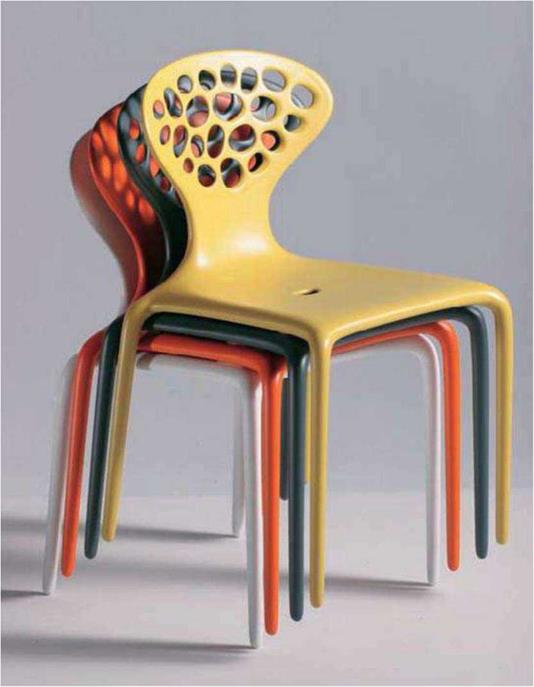
![]() The holes in the back of the Supernatural—designed to look like pinholes in a stretched balloon or a leaf that’s been eaten away—work aesthetic double duty by throwing a shadow pattern where the light sifts through. Credit: Alessandro Paderni, Eye Studio
The holes in the back of the Supernatural—designed to look like pinholes in a stretched balloon or a leaf that’s been eaten away—work aesthetic double duty by throwing a shadow pattern where the light sifts through. Credit: Alessandro Paderni, Eye Studio

